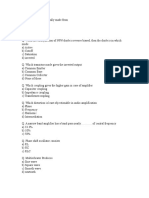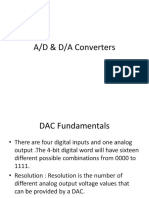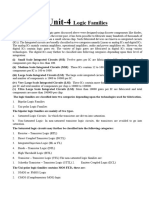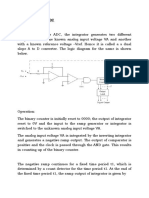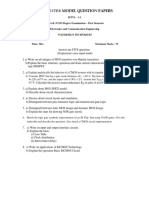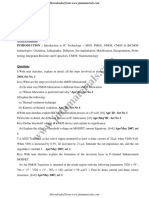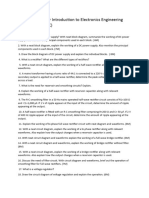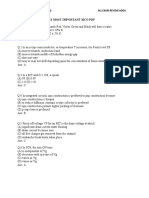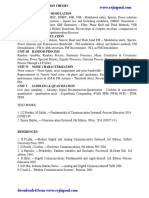0 ratings0% found this document useful (0 votes)
335 views39 pagesDigital Electronics
converters DAC and ADC
Uploaded by
RoohinazCopyright
© © All Rights Reserved
We take content rights seriously. If you suspect this is your content, claim it here.
Available Formats
Download as PDF or read online on Scribd
0 ratings0% found this document useful (0 votes)
335 views39 pagesDigital Electronics
converters DAC and ADC
Uploaded by
RoohinazCopyright
© © All Rights Reserved
We take content rights seriously. If you suspect this is your content, claim it here.
Available Formats
Download as PDF or read online on Scribd
You are on page 1/ 39
D/A and A/D Converters,
VFC and FVC
6.1 Introduction
‘The primary objective of industrial process control is to control physical parameters
such as temperature, pressure, flow rate, level, force, light intensity, and so on. The process
control system is designed to maintain these parameters near some desired specific value.
‘As these parameters can change either spontaneously or because of external influences, we
must constantly provide corrective action to keep these parameters constant or within the
specified range.
To control the process parameter, we must know the value of that parameter and
hence it is necessary to measure that parameter. In general, a measurement refers to the
transduction of the process parameter into some corresponding analog of the parameter,
such as a pneumatic pressure, an electric voltage, or current. A transducer is a device that
performs the initial measurement and energy conversion of a process parameter into
analogous electrical or pneumatic information. Many times further transformation or signal
enhancement may be required to complete the measurement function. Such processing is
known as signal conditioning.
Most of the information carrying signals such as voltage, current, charge, temperature,
pressure and time are available in the analog form. However, for processing, transmission
and storage purposes, it is often more convenient to express such signals in the digital
form. When expressed in the digital form, they provide better accuracy and reduce noise.
Moreover, the development in the microprocessor technology has made it compulsory
to process data in the digital form. Since digital systems such as microprocessor use a
binary system of ones and zeros, we have to convert signal from analog form to digital
form, The circuit that performs this conversion is called an analog to digital (A/D)
converter. Once the signal is measured it is used to
* Compare with set value and determine the control signal in the process control
system or
© Generate desired output by processing the signal.
The term digital signal processing, or DSP, is a very general term used to describe any
system which accepts samples of a signal with an A/D converter, processes the samples
with a microcomputer, and sends the computed result to a D/A converter or some other
device. The Fig. 6.1 shows the basic elements of digital signal processing system. Most of
(6-1)
Analog and Digital Electronics 6-2 DIA and A/D Converters, VFC and FVC
the signals generated are analog in nature. Hence these signals are converted to digital
form by the analog to digital converter. Thus the A/D converter generates an array of
samples and gives it to the digital signal processor. This array of samples (or sequence of
samples) is the digital equivalent of input analog signal. It is called digital signal. The
digital signal processor performs signal processing operations like filtering, multiplication,
transformation, amplification etc. over this digital signal and generates another digital
signal at its output. The digital signal processor can be a high speed digital computer and
specially designed digital signal processor. Digital signal processors perform signal
Processing operations with the help of the software, which decides the type of operation.
Usually, the digital output signal from digital signal processor is given to digital to analog
converter. The digital to analog converter gets an analog equivalent of the output digital
signal.
Analog,
signal
Analog
[signal
Fig, 6.1 Basic elements of a digital signal processing
6.2 D/A Converters
A DAC (Digital to Analog
Converter) accepts an n-bit input
word by, by, b3, . by in binary
and produce an analog signal Vg = Analog output
proportional to it. Fig. 6.2(a) shows
circuit symbol and input-output
characteristics of a 4-bit DAC.
There are four digital inputs,
indicating 4-bit DAC. Each digital
input requires an electrical signal
eae 0. ihe t, a eee least Fig. 6.2 (a) DAC circuit symbol
significant bit, LSB, whereas b, is the most significant bit, MSB.
Fig. 6.2 (6) shows analog output voltage V, is plotted against all 16 possible digital
input words.
by by By ..p, = Digital inputs
Vors—-15 8
“4 Dashed envelope of 14
13) ‘output voltage vs. 13
digital
o @ ‘onan 12
30 "
£10 0
8 4 4
ge :
zs 7 7
2 & 6
5 5
‘ Output value for 4
3 1 LSB input 3
2 2
1 1
0
b—-e- opr e rer ote r or ee
bo op PO Or KOO HPP OOK
b—-o oo or Ke HOD oor ee
a
Fig. 6.2 (b)
6.2.1 Performance Parameters of DAC
The various performance parameters of DAC are,
Resolution
Resolution is defined in two ways.
+ Resolution is the number of different analog output values that can be provided
by a DAG. For an n-bit DAC
resolution = 2"
‘+ Resolution is also defined as the ratio of a change in output voltage resulting
from’a change of 1 LSB at the digital inputs. For an n-bit DAC it can be given as
where,
resolution =
“ors
m4
Yaps = Full scale output voltage
‘Ve Value in LSBs
D/A and A/D Converters, VFC and FVC
(dy
@
From equation 1, we can say that, the resolution can be determined by the number of
bits in the input binary word. For an -bit DAC resolution can be given as
Analog and Digital Electronics 6-4 D/A and A/D Converters, VFC and FVC
resolution = 2" = 28
= 256
If the full scale output voltage is 10.2 V then by second definition the resolution for an
B-bit DAC can be given as
Mors _ 102 _ 102
==> = Gee = 40 mV/LSB
resolution =
27-1 28-4 255
Therefore, we can say that an input change of 1 LSB causes the output to change by
40mv.
From the resolution, we can obtain the input-output equation for a DAC.
Thus V,, = resolution x D
where D = decimal value of the digital input
and Vg = output voltage
The resolution takes care of changes in the input.
Accuracy
It is a comparison of actual output voltage with expected output. It is expressed in
percentage. Ideally, the accuracy of DAC should be, at worst, + , of its LSB. If the full
scale output voltage is 10.2 V then for an 8-bit-DAC accuracy can be given as
N,
Accuracy = —oS__ -@
ny ®
102
= o55x0 7 20 mV
Monotonicity
A converter is said to have good monotonicity if it does not miss any step backward
when stepped through its entire range by a counter.
Conversion Time
It is a time required for conversion of analog signal into its digital equivalent. It is also
called as setting time. It depends on the response time of the switches and the output of
the amplifier.
Settling Time
This is the time required for the output of the DAC to settle to within + 1/2 LSB of
the final value for a given digital input i. zero to full scale.
Stability
The performance of converter changes with temperature, age and power supply
variations. So all the relevant parameters such as offset, gain, linearity error and
monotonicity must be specified over the full temperature and power supply ranges. These
parameters represent the stability of the converter.
Analog and Digital Electronics. 6-5 D/A and A/D Converters, VFC and FVC
nm Example 6.1: An 8 bit DAC has an output voliage range of 0 - 2.55 V. Define its
resolution in two ways.
Solution : For the given DAC,
n = number of bits = 8
i) resolution = 2" = 28 = 256
ie, the output voltage can have 256 different values including zero.
ii) Vopg = Full scale output voltage
Vers, 2.55 _ 10mV
* resolution = Sm = TSB
Thus an input change of 1 LSB causes the output to change by 10 mV.
=> Example 6.2: The digital input for a 4-bit DAC is 0110. Caleulate its final output
voltage.
Solution : For given DAC,
n=4
Vors = 15.V
A resolution = 2S. = —15_ = 1 v/isp
2-1 2t4
resolution x D
Now D = decimal of (0110), = 6
Vz = 1V/LSBx6=6V
‘> Example 6.3: An 8 bit DAC has resolution of 20 mV/LSB. Find Vipq and V, if the
input is (10000000),
Solution: sesatution = ate
\,
29 = ors.
a
Vors = 5:1 V
D = equivalent of (10000000) = 128
V,, = resolution x D = 20 x 128 = 256 V
‘mp Example 6.4: Find out stepsize and analog output for 4-bit R-2R ladder DAC when
input is 1000 and 1111. Assume Vig =+5V.
Analog and Digital Electronics 6-6 D/A and A/D Converters, VFC and FVC
Solution : For given DAC, = 4, Vops = +8V
\
Resolution = “ors. 5 __ 1 visp
eal 2.4 3
o \, = Resolution x D
For D = decimal of (1000), = 8
VY = 4x8 = 2.6667 V
For D = decimal of (1111), = 15
Ve = Jas a5.
wm Example 6.5: A 12-bit DAC has a step size of 8 mV. Determine the full scale output
voltage and percentage resolution. Also find the output voltage for the input of
010101101101?
Solution : For 12-bit DAC, step size is &mV.
Vors = &mVx(2! -1) = 32.76 V
fon = S@Y t00 2
% Resolution = Ba 79™ 100 = 0.02442
‘The output voltage for the input 010101101101 is = 8mVx(1389)9 = 11.112 V
6.2.2 Basic Conversion Techniques
‘There are mainly two techniques used for analog to digital conversion
* Binary weighted resistor D/A converter
© R/2R ladder D/A converter
In these techniques, the shunt resistors are used to generate n binary weighted
currents, These currents are added according to switch positions controlled by the digital
input and then converted into voliage to give analog voltage equivalent to the digital
input. Therefore, such digital to analog converters are called current driven DACs.
Binary Weighted Resistor D/A Converter
‘The binary weighted resistor DAC uses an op-amp to sum n binary weighted currents
derived from a reference voltage Vp via current scaling resistors 2R, 4R, 8R, ..., 2" R, as
shown in the Fig. 6.3.
As shown in the Fig. 6.3, switch positions are controlled by the digital inputs, When
digital input is logic 1, it connects the corresponding resistance to the reference voltage Vp;
‘otherwise it leaves resistor open. Therefore,
Analog and Digital Electronics 6-7 D/A and A/D Converters, VFC and FVC
by b2 Bs bn
For ON-switch, I = —® and
For OFF-switch, I= 0
Here, operational amplifier is used as a summing amplifier. Due to high input
impedance of op-amp, summing current will flow through Rj. Hence the total current
through R; can be given as
Ip = tht teeth,
The output voltage is the voltage across Ry and it is given as
Vo = = 0.5625 Vp = 2.8125 V
Analog and Digital Electronics 6-10 DIA and A/D Converters, VFC and FVG
The inverting R/2R ladder DAC works on the principle of summing currents and it is
also said to operate in the current mode, An important advantage of the current mode is
that all ladder node voltages remain constant with changing input codes, thus avoiding
any shutdown effects by stray capacitances.
R/2R Ladder D/A Converter
In this type, reference voltage is applied to one of the switch positions, and other
switch position is connected to ground, as shawn in the Fig. 6.6.
Fig. 6.6 R/2R ladder D/A converter
Let us consider 3-bit R/2R ladder DAC with binary input 001, as shown in the
Fig. 6.7.
Fig. 6.7 3-bit RI2R ladder DAC
Analog and Digital Electronics 6-11 D/A and A/D Converters, VFG and FVG
Reducing above network to the left by Thevenin's theorem we get,
Fig, 6.8 (b)
R
‘
env
be s+
Fig. 6.8 (c)
Therefore, the output voltage is Vz/8 which is equivalent to binary input O01.
For binary input 100 the network can be reduced as follows :
Fig. 6.9 (a)
Analog and Digital Electronics
D/A and A/D Converters, VFC and FVC
Vpl2 = Va
Fig. 6.9 (b)
Therefore, the output voltage is Vp/2, which is equivalent to binary input 100.
In general, the expression for V, can be obtained as,
Let Tye: = Output current
R, = feedback resistance of op-amp
* Vo = ~ Tout Rp
Now Tye = current resolution x D
* V, = ~ (current resolution x D) Ry
* Vz = ~ (current resolution x R)) x D we (1)
The coefficient of D is the voltage resolution and can be called as simple resolution.
V, = ~ resolution x D ae (12)
In terms of actual circuit elements, output can be written as,
Vay t
Vy = (Ct eh fo (13)
resolution = w+» (14)
while the resolution fo R/2R ladder type DAC with voltage output is,
. 1. VR
resolution = (rt em wne(15)
imp Example 6.6 : Suggest the values of resistors and reference voltage if resolution required
is 0.5 V for 4 bit R/2R ladder type DAC.
Vr
Solution : resolution = {xR Re
7 R
Let Va = 10 V, n= 4 and resolution = 05
110
05 = wR Ry
R
“ eer = 15
Ry
Analog and Digital Electronics 6-13 D/A and A/D Converters, VFC and. FVC
Choose R, = 10k
” R=L5Q
Advantages of RI2R ladder DACs :
1, Easier to build accurately as only two precision metal film resistors are required
2. Number of bits can be expanded by adding more sections of same R/2R values.
3. In inverted R/2R ladder DAC, node voltages remain. constant with changing input
binary words. This avoids any slowdown effects by stray capacitances.
6.2.3 Sources of Errors in DAC
There are mainly three errors in DACs : Linearity, offset and gain errors.
Linearity Error
The error is defined as
wl —* Ideat the amount by which the
set actual output differs from
aot Non linearity the ideal __ straight-line
output.
ve
Fig. 6.10 shows the
linearity error in the transfer
characteristics of DAC. It is
mainly due to the errors in
Fig. 6.10 Linearity error in transfer characteristics of the current source resistor
DAG values.
26--
184
0
Offset Error
The offset error is
Actual —2///o— Ideal defined as the nonzero
level of the output voltage
when all inputs are zero.
It adds a constant
value to all output values,
as shown in Fig. 6.11.
It is due to the
presence of offset voltage
in op-amp and leakage
Fig. 6.11 Offset error in transfer characteristics of DAC currents in the current
switches.
Analog and Digital Electronics 6-14 D/A and AID Converters, VFC and FVC
Gain Error
78 +
ef Gain Emor
Fig. 6.12 Gain error in tansfer characteristics of
6.2.4 IC 1408 D/A Converter Devices
Fig. 6.13 (a) Pin diagram
It is defined as the
difference between the calculated
gain of the current to voltage
converter and the actual gain
achieved. It is due to the errors
in the feedback resistor on the
current to voltage converter
op-amp.
Fig. 6.12 shows the gain
error in transfer characteristics
of DAC.
The 1408 is an 8 bit R/2R
ladder type D/A converter
compatible with TTL and CMOS
logic. It is designed to use
where the output current is
linear product of an eight bit
digital word.
Fig. 6.13 (@) shows the pin
diagram and block diagram for
Ic 1408 DAC.
The IC 1408 consists of a
reference current amplifier, an
R/2R ladder and eight high
speed current switches. It has
eight input data lines A, (MSB)
through Ag (LSB) which control
the positions of current switches.
It requires 2.mA reference current for full scale input and two power supplies
Voc= +5 Vand Veg = - 15 V (Veg can range from - 5 V to - 15 V).
‘The voltage Vrei and resistor Ry, determines the total reference current source and Rys
is generally equal to R,, to match the input impedance of the reference current amplifier.
Analog and Digital Electronics 6-45 DIA and A/D Converters, VFC and FVC
MsB LsB
‘Compensation
E
EL
NPN Current source pair
Fig. 6.13 (b) Block diagram
Fig, 6.14 shows a typical circuit for IC 1408.
The output current I, can be given as
vi A A, A. A,
= Met (At +As Ar, As
Ry ( 2+ 64” 128 2] 8)
Note ; Input A; through Ag can be either 0 or 1. Therefore, for typical circuit full
scale current can be given as,
_ 5 flit
l= zaK(2*et 8" 16
_ 2mAx 255
“36
= 1992 mA
Analog and Digital Electronics
D/A and A/D Converters, VFC and FVC
B-bit
digit
input
Fig. 6.14 Typical circuit for IG 1408
It shows that the full scale output current is always 1 LSB less than the reference
current source of 2 mA. This output current is converted into voltage by I to V converter.
The output voltage for full scale input can be given as
Vo = 1.992% 2.5K
= 4.98 V
Note : The arrow on the pin 4 shows the output current direction. It is inward. This
means that IC 1408 sinks current. At (0000 0000), binary input it sinks zero current and at
(11111111), binary input it sinks 1992 mA.
The circuit shown in the Fig. 6.14 gives output in the unipolar range. When digital
input is 00H, the output voltage is 0V and when digital input is FFH (11111111), the
output voltage is + 5 V. This circuit can be modified to give bipolar output.
Fig. 6.15 shows the circuit for giving output in the bipolar range. Here, resistor
Rg(S K) is connected between Vyer and the output terminal of IC 1408. This gives a
constant current source of 1 mA.
The circuit operation can be observed for three conditions :
Condition 1 : For binary input (00H)
When binary input is 00H, the output current I, at pin 4 is zero. Due to this current
flowing through Rg (1 mA) flows through Ry giving Vo = - 5 V.
Bbit
digitat
input
EE
Fig. 6.15 Interfacing DAC in the bipolar range
Condition 2 : For binary input 60H.
When binary input is 80H, the output current I, at pin 4 is 1 mA. By applying KCL at
node A we get,
-Igtly+lp = 0
Substituting values of Ig and I, we get,
(1 mA) + (1 mA) + I,
"
°
= 0
and therefore the output voltage is zero.
Condition 3 ; For binary input FFH
When binary input is FFH, the output current I, at pin 4 is 2 mA. By applying KCL at
node A we get,
-Iy +I #1,
substituting values of Ig and |, we get,
- (mA) + @QmA) +], = 0
ly = -1mA
Therefore, the output voltage is + 5 V. In this way, circuit shown in the Fig. 6.15 gives
output in the bipolar range.
"
°
6-18
D/A and AID Converters, VFC and FVC
and Digital Electronics
Important Electrical Characteristics for IG 1408
:2mA
2 +5 Veg and —
© Reference current
Supply voltage
© Setting time 3300 ns
© Full scale output current: 1,992 mA
© Accuracy 0.19 %
6.3 AID Converters
Analog Input ane
be Dy be Dy
Fig. 6.16 Symbol for 4 bit ADG
6.3.1 Performance Parameters of ADC
15 V Veg
The A/D conversion is a
quantizing process whereby an
analog signal is converted into
equivalent binary word. Thus the
A/D converter is exactly opposite
function that of the D/A converter.
Fig. 6.16 shows symbol for
A/D converter.
‘The Fig. 6.17 shows the digital output of an ideal 3 bit ADC plotted against the analog
input voltage.
718
Digital output
Analog input
Fig. 6.17 Analog input Vs Digital output
Ideal Transition
Ideally quantized
analog input
Analog and Digital Electronics 6-19 D/A and A/D Converters, VFC and FVG
Let us define the performance parameters of ADC, referring to the Fig. 6.17, which
shows the output-input characteristics of ADC,
Resolution
Fig. 6.17 shows eight (2°) discrete output states from 000, to 111,, each step being iv
apart. Therefore, we can say that expression of ADC resolution is the same as for the DAC
and is repeated here :
resolution = 2" 17
Resolution is also defined as the ratio of a change in value of input voltage, V;, needed
to change the digital output by 1 LSB. If the full scale input voltage required to cause a
digital output of all 1's is Vipg, then resolution can be given as
resolution = —Y#S_ ves (18)
2-1
Quantization Error
Fig. 6.17 shows that the binary output is 011 for all values of ¥; between 4 and UV.
There is an unavoidable uncertainty about the exact value of V, when the output is O11.
This uncertainity is specified as quantization error. Its value is + 3 LSB.
It is given as,
s+ (19)
Increasing the number of bits results in a finer resolution and a smaller quantization
error.
Conversion Time
It is an important parameter for ADC. It is defined as the total time required to
convert an analog signal into its digital output. It depends on the conversion technique
used and the propagation delay of circuit components.
tmp Example 6.7 : An 8-bit ADC outputs all 1’s when V, = 5.1 V. Find its a) Resolution and
b) Digital output when V; = 1.28 V
Solution : a) From equation (20) we have,
resolution = 2° = 256
and from equation (18) we have,
resolution = 21% = 29 mv/LsB
28-1
Therefore, we can say that to change output by 1 LSB we have to change input by
20 mV.
Analog and Digital Electronics 6-20 DIA and AID Gonverters, VFG and FVG
b) For 1.28 V analog input, digital output can be calculated as,
128V
D = ——"*__ = 64 LSBs
20 mV / LSB
The binary equivalent of 64 is 0100 00005
iam Example 6.8 : Calculate the quantizing error for 12-bit ADC with full scale input voltage
4.095 V.
Solution ; From equation (19) we get
4095
Q, = — _
EB (22 =1x2
6.3.2 Basic Conversion Techniques
Analog to digital converter are classified into two general groups based on the
conversion techniques. One technique involves comparing a given analog signal with the
internally generated reference voltages. This group includes successive approximation,
flash, delta modulated (DM), adaptive delta modulated and flash type converters. The
another technique involves changing an analog signal into time or frequency and
comparing these new parameters against known values. This group includes integrator
converters and voltage-to-frequency converters.
In this chapter we are going to discuss following types of ADCs using various
conversion techniques :
1. Single ramp or single slope 2. Dual slope
3. Successive approximation 4. Flash
5. Delta modulation 6. Adaptive delta modulation
Single Slope ADC
It consists of a ramp generator and BCD or binary counters. The Fig. 6.18 shows the
single slope ADC.
Ciéck o
Fig. 6.18 Single slope ADC
Analog and Digital Electronics 6-21 D/A and A/D Converters, VFC and FVC
At the start, the reset signal is provided to the ramp generator and the counters. Thus
counters are resetted to 0's. The analog input voltage Vin is applied tc the positive
terminal of the comparator. As this is more positive than the negative input, the
comparator output goes high. The output of ramp generator is applied to the negative
terminal of the comparator. The high output of the comparator enables the AND gate
which allows clock to reach to the counters and also this high output starts the ramp.
The ramp voltage goes positive until it exceeds the input voltage. When it exceeds Vig,
comparator output goes low. This disables AND gate which inturn stops the clock to the
counters. The control circuitry provides the latch signal which is used to latch the counter
data. The reset signal resets the counters to 0’s and also resets the ramp generator. The
latched data is then displayed using decoder and a display device.
Let us consider the practical example to understand the working. Assume that the
clock frequency is 1 MHz. There are four BCD counters and the input Vin is 2.000 V.
Now let ramp has a slope of 1V/ms as
shown in the Fig. 6.19. As the input is 2.000 V,
the ramp will take 2 ms to reach to 2 V and to
volts v stop the clock to the counters.
KoA Now how many pulses will reach to the
ms counters during 2 ms ? It can be calculated
ms from the frequency of the clock. The number
of pulses reaching to the counter in 2 ms is
Fig. 6.19
= 2000. The comparator output
(7 IMAa)
going high will strobe. The latches and send the count to the displays. Inserting a decimal
point at the proper point in the seven segment display gives a reading of 2.000. But we
want binary output. In such case instead of BCD counters, binary counters must be used,
where output will be straight binary coded.
The main limitations of this circuit are,
i) Its resolution is less. Hence for applications which require resolution of 9 part in
20,000 or more, this ADC is not stable.
ii) Variations in ramp generator due to time, temperature or input voltage sensitivity
also cause a lot of problems.
Dual Slope ADG
Dual slope conversion is an indirect method for A/D conversion where an. analog
voltage and a reference voltage are converted into time periods by an integrator, and then
measured by a counter. The speed of this cunversion is slow but the accuracy is high.
Fig. 6.20 shows a typical dual slope converter circuit. It consists of integrator (ramp
generator), comparator, binary counter, output latch and reference voltage. The ramp
generator input is switched between the analog input voltage V, and a negative reference
voltage, Vace. The analog switch is controlled by the MSB of the counter. When the MSB
Analog and Digital Electronics 6-22 DIA and A/D Converters, VFC and FVG
is a logic 0, the voltage being measured is connected to the ramp generator input. When
MSB is logic 1, the negative reference voltage is connected to the ramp generator.
input
Veer
Digital output
Fig. 6.20 Dual slope A/D converter
Fig. 6.21 Integrator output voltage
At time t = 0, analog switch S is connected to the analog input voltage Vj, so that the
analog input voltage integration begins. The output voltage of the integrator can be given
sve (20)
Analog and Digital Electronics 6-23 D/A and A/D Converters, VFC and FVC
where R, C, is the integrator time constant and Vj is assumed constant over the
integration time period. At the end of 2N clock periods MSB of the counter goes high. At a
result the output of the flip-flop goes high, which causes analog switch S to be switched
from Vj to -Vg. At this very same time the binary counter which has gone through its
entire count sequence is reset.
The negative input voltage (-Vp) connected to the input of integrator causes the
integrator output to ramp positive. When integrator output reaches zero, the comparator
‘output voltage goes low, which disables the clock AND gate. This stops the clock pulses
teaching the counter, so that the counter will be stopped at a count corresponding to the
number of clock pulses in time ty.
The integrator output ramp down to a voltage V and get back upto 0. Therefore, the
charge voltage is equal to discharge voltage and we can write,
Mti _ Mete
Re RG
Vity = Vp ty
a ty was (21)
YR
The above equation shows that t, is directly proportional only to the V;, since Vp and
ty are constants. The binary digital output of the counter gives corresponding digital value
for time period t and hence it is also directly proportional to input signal Vj.
The actual conversion of analog voltage V;, into a digital count occurs during tj. The
control circuit connects the clock to the counter at the beginning of t;. The clock is
disconnected at the end of t,. Thus the counter contents is digital output. Hence we can
write,
digital output (Sant } 2 (22)
second
But from (21) we can write,
counts \, (Vj
(Sema) (sf) 3)
The counter output can then be connected to an appropriate digital display.
The advantages of dual slope ADC are
1. It is highly accurate.
2. Its cost is low.
3. It is immune to temperature caused variations in R, and C,.
‘The only disadvantage of this ADC is its speed which is low.
digital output
tus Example 6.9 : For a particular dual slope ADC, t, is 83.33 ms and the reference voltage
is 100 mV. Calculate ty if i) V; is 100 mV and ii) 200 mV.
Analog and Digital Electronics 6-24 D/A and A/D Converters, VFC and FVC
Solution : We know that,
=“
vet
= (300) 339
= 83.33 ms
= 200 mV
be (ian )o339
= 166.6 ms
ii)
ump Example 6.10 : Fini! the digital output of an ADC having 1, as 83.33 ms and Vp as
100 mV for an input voltage of + 100 mV. The clock frequency is 12 kHz.
Solution : The digital output is given as,
voi counts), (¥
digital output = (3). ()
Now Clock frequency = 12 kHz
ie. = 12000 US
second
. isi _ 10 3
n igital output = 12000 x 83.33 (755 x 10”
= 1000 counts.
Successive Approximation ADC
In this technique, the basic idea is to adjust the DAC’s input code such that its output
is within + }4 LSB of the analog input V; to be A/D converted. The code that achieves this
represents the desired ADC output
The successive approximation method uses very efficient code searching strategy called
binary search. It completes searching process for n-bit conversion in just n clock periods.
Fig. 6.22 shows the block diagram of successive approximation A/D converter. It
consists of a DAC, a comparator, and a successive approximation register (SAR).
The external clock input sets the internal timing parameters. The control signal start of
conversion (SOC) initiates an A/D conversion process and end of conversion signal is
activated when the conversion is completed.
Analog and Digital Electronics 6-25 DIA and A/D Converters, VFC and FVC
Start of End of
‘conversion (SOC) conversion (EOC)
Vio
Analog input
Output of DAC
Fig, 6.22 Block diagram of successive approximation AID converter
Operation ;
The searching code process in successive approximation method is similar to weighing
an unknown material with a balance scale and a set of standard weights. Let us assume
that we have 1 kg, 2 kg and 4 kg weights (SAR) plus a balance scale (comparator and
DAC). Now we will see the successive approximation analogy for 3-bit ADC.
Refer Fig. 6.22 and 6.23. The analog, voltage Vin is applied at one input of comparator.
On receiving start of conversion signal (SOC) successive approximation register sets 3-bit
binary code 100, (b, = 1) as an input of DAC. This is similar process of placing the
unknown weight on one platform of the balance and 4 kg weight on the other. The DAC
converts the digital word 100 and applies its equivalent analog output at the second input
of the comparator. The comparator then compares two voltages just like comparing
unknown weight with 4 kg weight with the help of balance scale. If the input voltage is
greater than the analog output of DAC, successive approximation register keeps b = 1
and makes b, = 1 (addition of 2 kg weight to have total 6 kg weight) otherwise it resets
by = O and makes b; = 1 (replacing 2 kg weight), The same process is repeated for by and
bg. The status of bg, b, and b, bits gives the digital equivalent of the analog input.
Fig. 6.23 illustrates the process we have just discussed.
The dark lines in the Fig. 6.23 shows setting and resetting actions of bits for input
voltage 5.2 V, on the basis of comparison. It can be seen from the Fig. 6.23 that one clock
pulse is required for the successive approximation regsiter to compare each bit. However
an additional clock pulse is usually required to reset the register prior to performing a
conversion.
Analog and Digital Electronics 6-26 DIA and AID Converters, VFC and FVC:
Start of conversion (SOC)
Start
End CL
Cock Le LL
Compare Compare Compare
MsB by by baby by
om 000
Fig. 6.23 Illustration of conversion process
The time for one analog to digital conversion must depend on both the clock’s period
T and number of bits n. It is given as,
To =Tm+t
where Te = conversion time
T = clock period
number of bits
(24)
"
W
Analog and Digital Electronics 6-27 D/A and A/D Converters, VFC and FVC
im Example 6.11: An & bit successive approximation ADC is driven by a 1 MHz clock.
Find its conversion time.
Solution : f = 1 MHz
1 1
Tecies = 1 psec
Fteoe |
n=8
” To = Tin+ 1) =1@+ 1) =9 psee.
Flash ADC or Parallel Comparator ADC
When system designs call for the highest speed available, flash-type A/D converters
(ADCs) are likely to be the right choice. They get their names from their ability to do the
conversion very rapidly. Flash A/D converters, also known as a simultaneous or parallel
comparator ADC, because the fast conversion speed is accomplished by providing 2° - 1
Fig. 6.24 3-bit flash converter
Analog and Digital Electronics 6-28 DIA and A/D Converters, VFC and FVC
comparators and simultaneously comparing the input signal with unique reference levels
spaced 1 LSB apart.
Fig. 6.24 shows 3-bit flash A/D converter. For this ADC, seven (2 - 1) comparators are
required. As shown in the Fig. 6.24, one input of each comparator is connected to the
input signal and other input to the reference voltage level generated by the reference
voltage divider, The reference voltage (Vggr ) is equal to the full scale input signal voltage.
‘The manner in which the flash A/D converter performs a quantization is relatively simple.
The comparators give output “1" or “0” state depending on whether the input signal is
above or below the reference level at that instant. Those comparators referred above the
input signal, remain turned-off, representing a “O" state. The comparators at or below the
input signal conversely become a “i” state. The code resulting from this comparator is
converted to a binary code by the encoder.
The number of comparators required for n bit resolution is,
number of comparators = 2" —1 25)
As seen earlier the quantization error is ++ } LSB. Thus for an ADC, the maximum
frequency for a sine wave Vin to be digitised within an accuracy of + 5 LSB is,
1
“Sa (26)
where fnax = maximum input frequency
Tg = conversion time
n = number of bits
‘ump Example 6.12: For a particular 8-bit ADC, the conversion time is 9 ys. Find the
maxinnum frequency of an input sine wave that can be digitized.
Solution : The maximum frequency is given by,
£4, = —b— «= __1__
mex 2x(Te)2" — Qxx 9x10 x 28
~ 69.07 Hz
Comparison between Flash, Dual Slope and Successive Approximation
Techniques
The comparison of ADCs is given in the tabular form as below :
Parameter Flash Successive Dual slope
approximation
Speed Fastest Fast Slow
Accuracy Less Medium More
Resolution Upto 2° Upto 218 2'8 or even more
Analog and Digital Electronics
6-29
D/A and A/D Converters, VFC and FVC
AID Converter ICs
ADC 0803 Family
Input hold Depend on number of | It is maximum, hence
time ‘bits. It is more than flash | sample and hold circuit
AND converter is required
Cost Medium Less
Applications | High speed fiber optic | The successive ‘These are used when
cormmunicatian, Digital | approximation A/D high accuracy and
storage oscilloscope, converter has the resolution is required and
Imaging and many more | disadvantage of requiring | speed is not the
where high speed AID | DJA converter, but it has | important criteria.
conversion is required | the advantage of high
speed with excellent
resolution. Hence these
‘are most popular and
used in data acquisition
systems
1c |Resol-|Gon- | i¢ [Resol|Gonvers+ | ¢ _ |Resol |Conversi-
tion |version -ution Jon rate -ution |on rate
rate
ICs japeng0Ko| 6 [soma [Abciios | 8 | whe [adow; | i | 25He
japeoooso| 6 |rsmiz [ances | 10 | evox |ri09 12_|_ soni
frwt070 fs mitz [ADonioa | 12 | sooxte |aoetzco | 12 | zehz
foci + ps ADCTE urrsso0 2] zene.
The ADC 0803 and ADC 0805 are CMOS 8-bit successive approximation analog to
digital converters, These devices are design to operate from common microprocessor
control buses, with tri-state output latches driving the data bus.
Fig. 6.25 shows the pin diagram of ADC 0803 and ADC 0805.
Apc
0803)
0805,
Veo
ctx our
[5 peo
5 ost
[5 ps2
5 os
ops
Des
0B6
[5 087
18
7
16
15
14
9
12
DATA
‘OUTPUTS
Fig. 6.25 Pin diagram of ADCOB03/0805
IN+ and IN- inputs
allow application of
differential input voltage
which has high common
mode rejection and
eliminates offset due to the
zero input analog voltage
value. The devices can
operate with an external
clock signal or, the on chip
clock generator can be used
independently by adding
an external resistor and
capacitor to set the time
period.
Analog and Digital Electronics 6-30 DJA and AID Converters, VFC and FVC
The main features of these family are :
Features
‘© Bbit successive approximation ADC
© Conversion time 100 us
© Access time 135 ns
It has an on-chip clock generator
© It does not require any zero adjustment.
© It operates on single 5V power supply
© Output meet TTL voltage level specifications.
‘Operation
When the WR input goes low, the internal successive approximation register (SAR) is
reset. As long as both CS and WR remain low, the analog to digital converter will remain
in its reset state. One to eight clock periods after CS or WR makes a low-to-high transition,
conversion starts. The INTR signal is held high during conversion process. After
conversion, INTR goes low which is used as end of conversion signal. By making CS and
RD signals low, an output can be read through DBO to DB7 data signals.
ADC 0808/0809 Family
The ADC 0808 and ADC 0809 are monolithic CMOS devices with an channel
multiplexer. These devices are also designed to operate from common microprocessor
control buses, with tri-state output latches driving the data bus. The main features of these
devices are:
Features
© &bit successive approximation ADC
* 8channel multiplexer with address logic
© Conversion time 100 jis
© It eliminates the need for external zero and full-scale adjustments
«Easy to interface to all microprocessors
© It operates on single 5V power supply
© Output meet TIL voltage level specifications
Fig. 6.26 shows pin diagram of 0808/0809 ADC
ADC 0808/0809 has eight input channels, so to select desired input channel, it is
necessary to send 3-bit address on A, B and C inputs, The address of the desired channel
is senti to the multiplexer address inputs through port pins. After at least 50 ns, this
address must be latched. This can be achieved by sending ALE signal. After another 2.5 1s,
the start of conversion (SOC) signal must be sent high and then low to start the conversion
Process, To indicate end of conversion ADC 0808/0809 activates EOC signal. The
sor system can read converted digital word through data bus by enabling the
output enable signal after EOC is activated. This is illustrated in Fig. 6.27.
Analog and Digital Electronics 6-31 DIA and A/D Converters, VFC and FVC
° ? | analog
sea ‘ 1p a
inputs
6 A
7 B } Address
soc c
EOC ALE
DB3 DB7
OUTPUT CONTROL DBS
cu C] DBs
Vee DB4
reF+(] 12 DBO
GND REF
Det DB2
0c.
Fig. 6.27 Timing waveforms for ADC 0808
Ie 7109
The ICL 7109 is a high performance, low power integrating (Dual slope) A/D
converter designed to easily interface with microprocessor.
Analog and Digital Electronics 6-32 D/A and A/D Converters, VFC and FVC
Features
IC 7109 is a 12-bit dual slope A/D converter.
It has polarity and over range bits.
It has byte organized TTL compatible three-state outputs and UART handshake
mode for simple parallel or serial interfacing to microprocessor systems.
It has RUN/HOLD input-and STATUS output, which can be used to monitor and
control conversion timing.
ery
-
5. It has true differential input and differential reference
6. It has low noise-typically 15 WVp p+
7. It has very low input current - IpA
8. It operates at 30 conversions per second.
9. All inputs are fully protected against static discharge.
Pin Configuration and Test Circuit
The Fig. 6.28 shows typical circuit and pin configuration for 7109.
eno —{i] cn
Z| STATUS
POL
HIGH Aj0R
ORDER Biz
BYTE é len © Input high
a Z Input ow
a
3
IcL 7109.
RENIN® *RINT=20 ka
-0F 200K
REN/ OLD [26}
REFOSC OUT [25
‘osc set [24}- GND
ose OUT ae 3.5785 MHz
OSC IN
[za]
Fig. 6.28 Pin diagram of ICL 7109
Analog and Digital Electronics 6-33 DIA and A/D Converters, VFC and FVC
wom Example 6.13 : A 6-bit DAC has an input of 100101 and a 10 V reference.
Find ; i) Output voltage produced. ii) Conversion resolution.
Solution :
Ry
R2R3 R4 RS N4
S, 8,
s] Se] Ss] Sa] Sol
=| =) Sl =) =! evss) Vp
Fig. 6.29
= Ss, S, s.
«asi
“t
The voltage at node N ~ 1 i.e. 5 is
V’ = Lp. when only MSB is applied
In general output voltage Vo is
Vi= (enertgewerttsairte J2t¥
In our case
1 L
Vy e (Iro+o+g +043 |v) A
10
* Vy = (1.15625) "Oca
= 3.85416 x A volts
where A= 1+ & gain of non-inverting amplifier
‘1
Resolution = 2x12 4 = 0.104 volts
= gpg Ana
imp Example 6.14: The sample and hold (S/H) circuit shown in Fig. 6.30 was used in a
interface for temperature control. Show that the acquisition time for a step input of 10 V is
less than 100 41s. The op-amp 741 can supply a maximum of 25 mA. and the slew rate can
be neglected. The ON resistance of the FET is 30.Q. Assume an accuracy of 0.5 % of final
value.
Analog and Digital Electronics 6-34 DIA and A/D Converters, VFC and FVC
Gate
Fig. 6.30
Solution : Given : Rp oy(On resistance of FET) = 30.9,
The time constant, t = (R, + Rp ox) ©
where R, - output resistance of op-amp which is 75 Q for op-amp74l.
= (5 +30)
‘The capacitor C ean be given as C = Cy, (op-amp) + Coy (FET)
= 14 pF + 10 nF
= 10nF
¥ = 105% 10 = 1050 ns
For 0.5% tolerance, the hold capacitor voltage can be given as
Vc = Step input voltage - 0.5 % of Step input voltage
= 10-005
= 995 V
Vo = V(b-ert/RCy
9.95 = 10 (1 e°t/(50x10"%)
t = 556s
‘Therefore, time required to charge the capacitor (5.56 lis) upto 9.95 V which is very
much less than 100 pis.
imap Example 6.15: A dual slope uses a 8-bit counter and a 3 MHz clock rate. The
maximum input voltage is +10 V. The maximum integrator output voltage should be ~ 8 V,
when the counter cycled through 2's counts, The capacitor used in the integrator is 0.1 UF.
Find the value of 'R! of the integrator. How the RC-product limits the speed of ADC ?
Solution :
Analog and Digital Electronics 6-35 DIA and AUD Converters, VFC and FVC
Vy =
-8 = ——~__- (85.33) x10
Rx0.1x10% »
853.3
O.1R
R = 1066625.
Conversion time depends on RC time constant. The counter count is proportional to Vj,
and is independent of RC.
= Min
ne ob?
ii) If V, = 4.129 V and Vp = 8 V in the part (i). Obtain the digital count ‘N’ and also
obtain the digital output is 2's complement.
~ Mion
1s ye
_ 4.129
==
132 = 10000100
In 2's complerent the digital output will be = 01111100,
28
6.4 Voltage to Frequency Converter (VFC)
‘A voltage to frequency converter (VFC) produces a pulse train whose frequency is
linearly proportional to an analog input voltage,
four = ky Vi we (l)
In other words, it converts analog signals to digital form. The primary reason for this
type of conversion is that a pulse train can be transmitted and decoded much more
accurately than an analog signal, especially if the transmission path is long and noisy.
6.4.1 Typleal Specifications of VFCs
* wide dynamic range (more than four decades)
ability to operate to relatively high frequencies (hundreds of kHz, or higher)
© low linearity error (less than 0.1 percent deviation from the straight line going
from zero to full scale.)
© high scale-factor accuracy
© stability with temperature and supply voltage.
Analog and Digital Electronics 6-36 D/A and A/D Converters, VFC and FVC:
6.4.2 Types of VFC'S
According to the method of conversion there are two types of VECs :
* Wide sweep multivibrators and
* Charge-balancing VFCs
6.4.2.1 Wide-Sweep Multivibrator VFCs
Wide sweep multivibrator circuits are nothing but the voltage controlled astable
multivibrators designed with VFC performance specifications in mind. Such circuits. are
temperature stabilized. ADS537 is a popular VEC in this type from analog devices. Fig. 6.31
shows block diagram and basic connections for AD537.
Fig. 6.31
As shown in the block diagram conversion takes place in two steps ; Initially, input
voltage is converted to the current drive, and then current controlled oscillator (CCO)
produces pulses whose frequency is linearly proportional to the input current. The input
voltage is converted to the current drive with the help of op-amp and BJT combination.
The op-amp provides base current to ensure Vy= Vp. Thus I = V; /R. The CCO parameter
is such that,
I
fou = STOW ~@
Substituting value of I we get,
Analog and Digital Electronics 6-37 DIA and A/D Converters, VFC and FVG
t ¥
‘out ~ RO IOV --@)
For Ad537, this linear relationship. remains accurate over a dynamic range of atleast
four decades, upto a full-scale current of ImA and a full-scale frequency of 100 kHz. Let
us assume, C = 1 nF, R= 10 k and V¢c= 15 V. Now, variation of V; from 1 mV to 10 V
gives current and hence frequemcy variations as follows.
‘Current Variation : For 1 mV
Inv.
T= Ggpge = OMA
10V
For 10 V, les Tom = 1™4
Frequency variations : For 0.1 1A
01 A
fout = Tapciov = 10 He
0.1 mA
For 1 mA, fout = Tageigy = 100 KHz
‘The Rog (20 K pot) is connected to minimize the V-I conversion error at the low end
of the range. It does this by making input offset error of op-amp zero. The on chip
precision voltage reference stabilizes the CCO scale factor. The voltage references are also
made available with the help of terminals Vp (pin 7) and Vy (pin 6). Vp is stable 1.00 V
reference voltage and Vy is a voltage linearly proportional to absolute temperature T. It is
given by
Vy = ImV/°KxT.
6.4.2.2 Charge Balancing VFCs
In charge balancing technique, a capacitor is supplied with a continuous charge at a
rate linearly proportional to the input signal. Then capacitor is discharged and
simultaneously discrete charge pulse is generated with the help of one shot (monostable
multivibrator). Therefore, for each charge-discharge cycle one pulse is generated. The
repetition rate of these train of pulses is directly proportional to the input signal since
charge rate is linearly proportional to the input signal.
Fig. 631 shows block diagram of popular VEC32 monolithic VFC as a charge balancing
VEC.
‘As shown in the Fig. 6.31 (a) op-amp A, converts V; to current I = V,/R, which flows
into a summing node of Ay (inverting input of Ay). The value of R is chosen such that I is
always less than 1 mA. To understand circuit operation, let us consider switch SW is open.
Analog and Digital Electronics 6-38 D/A and A/D Converters, VFC and FVC
ee
Fig. 6.32 (a) Block diagram of VFC32
With SW open, current I flows into capacitor C, and causes the output of op-amp Ay
(Vg) to ramp downward, as shown in the Fig. 6.32 (b).
Vor
—y¥— ss —
Fig. 6.32 (b)
Analog and Digital Electronics 6-39 D/A and A/D Converters, VFC and FVC
As Vo1 reaches OV, comparator CMPI fires and triggers a precision one-shot, which
closes SW and turns on transistor Q, for a time interval Ty; set by C. The one-shot utilizes
an intemal threshold of 4.5 V and a charging current of ImA. This gives
75V
Ty = kc eal)
As soon as, switch is closed, a resultant current of magnitude (1mA - I) starts flowing
‘out of summing node of A;. This causes output voltage of Ay (Voi) to ramp upward by an
amount such that 4 Vo, = [mA ~ 1) Ty ]/ C}. After the timing interval of one shot ie.
after time Tyg. SW is opened and Vg; resumes ramping downward at a rate again set by L
The output voltage of A; (Vo}) takes time interval Ty to reach OV such that
AVo1 = 1 T/C).
Now relating Ty; and T,, with above equations we get
(1 mA -) Ty = TT, 8)
© ImATy-ITy = IT,
Dividing equation by I we get,
Tet = Th
ImA T,
Ty+T = 4 ~-(6)
1
We know that, faye = a ol)
. =i. we
* fot = TmaTy “RamaT) T= MAR
- i ep, = 25
* ROK TSV “Ta Tima © 6)
The above equation indicates that f,. is linearly proportional to Vj, as desired.
‘The percentage duty cycle is given as
Ty
oT 0)
Substituting value of Ty + Ty, we get,
= Tw =i
4% = Raat Ty" = AIO AO)
From equation 10 we can notice that duty cycle is also proportional to the input signal
7
You might also like
- Question Bank: Siddharth Group of Institutions:: PutturNo ratings yetQuestion Bank: Siddharth Group of Institutions:: Puttur23 pages
- 231 - Sample Placement Papers - Question Bank, Selection Procedures, Interview Tips)No ratings yet231 - Sample Placement Papers - Question Bank, Selection Procedures, Interview Tips)45 pages
- Sensors Actuators and Interface Electronics-Question Paper PDF75% (4)Sensors Actuators and Interface Electronics-Question Paper PDF2 pages
- BHEL Model Question Paper (Answers Updated) : A.) Resistanceb.) ReactanceNo ratings yetBHEL Model Question Paper (Answers Updated) : A.) Resistanceb.) Reactance28 pages
- ALL INDIA RADIO, Dibrugarh Report (Main)No ratings yetALL INDIA RADIO, Dibrugarh Report (Main)28 pages
- Ece Interview Question For Barc & NpcilNo ratings yetEce Interview Question For Barc & Npcil92 pages
- Digital Communication Lab Manual - BECL504No ratings yetDigital Communication Lab Manual - BECL50449 pages
- Digital Electronics & Fundamentals of Microprocessor Paper - IV100% (1)Digital Electronics & Fundamentals of Microprocessor Paper - IV2 pages
- Small Signal Analysis of Amplifiers (BJT & Fet) : Narayana Engineering College:: Nellore100% (2)Small Signal Analysis of Amplifiers (BJT & Fet) : Narayana Engineering College:: Nellore12 pages
- NPCIL ET Electronics Question Paper 2011 Model Paper With AnswersNo ratings yetNPCIL ET Electronics Question Paper 2011 Model Paper With Answers7 pages
- Department of EJ/EN/EQ/ET/EX 22423 Linear Integrated Circuit MCQ Questions and AnswersNo ratings yetDepartment of EJ/EN/EQ/ET/EX 22423 Linear Integrated Circuit MCQ Questions and Answers29 pages
- Pulse Code Modulation (PCM) .: Basic Elements of PCMNo ratings yetPulse Code Modulation (PCM) .: Basic Elements of PCM2 pages
- Digital Principals and Applications - D. P. Leach and A. P. Malvino33% (3)Digital Principals and Applications - D. P. Leach and A. P. Malvino217 pages
- AP Genco Assistant Engineer Electronics: Model Question PaperNo ratings yetAP Genco Assistant Engineer Electronics: Model Question Paper24 pages
- ISRO VSSC Technical Assistant (Electronics) Official Paper (Held On - 30 July 2023)No ratings yetISRO VSSC Technical Assistant (Electronics) Official Paper (Held On - 30 July 2023)22 pages






